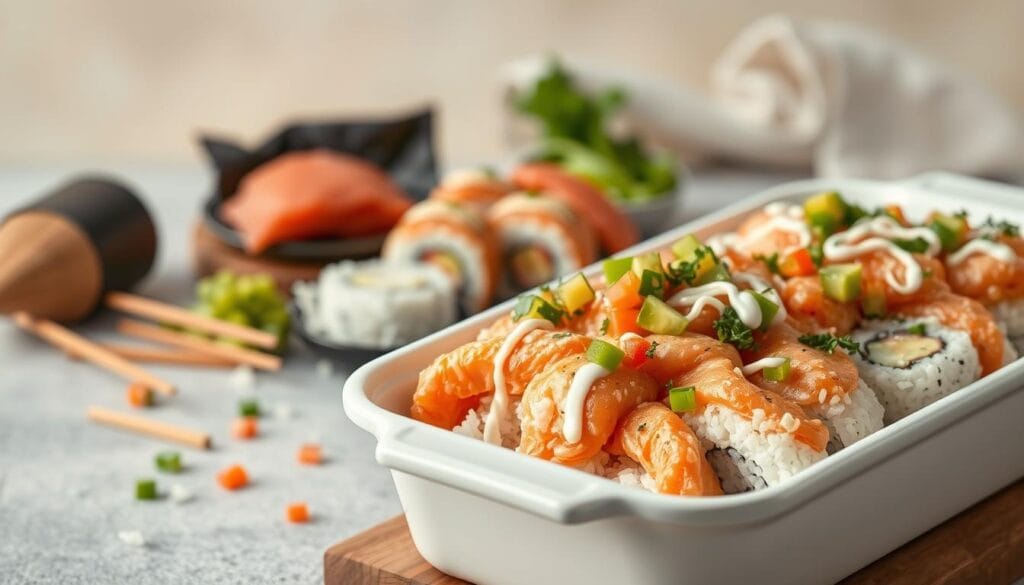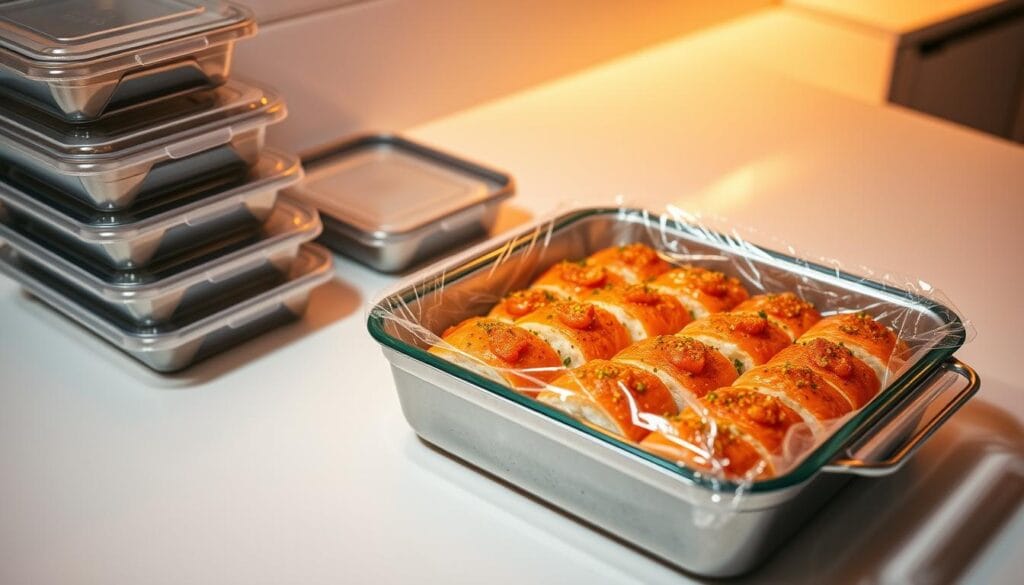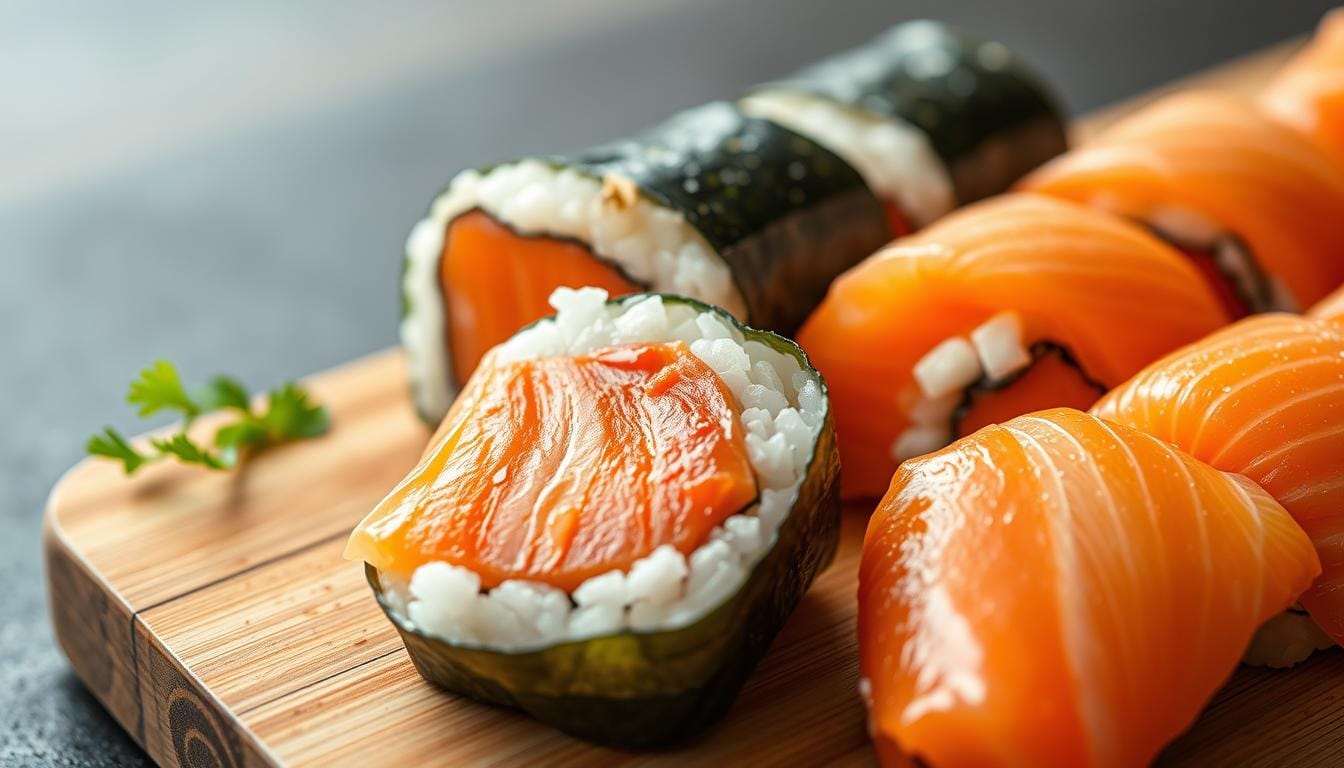Ever crave a meal that feels indulgent but doesn’t derail your health goals? Picture this: tender flakes of salmon, seasoned to perfection, nestled atop a bed of sticky rice and wrapped in crisp seaweed. It’s the kind of dish that looks like a restaurant specialty but takes minutes to make at home. And guess what? You won’t believe a cooked salmon sushi under 400 calories.
Inspired by viral food trends—like @emilymariko’s famous salmon bowl and The Modern Nonna’s creative twists—this recipe reimagines sushi as a quick, wholesome meal. No raw fish or advanced techniques required. Just simple ingredients you likely already have: rice, salmon, and seaweed. The best part? It’s packed with protein and balanced macros, making it ideal for busy weeknights or meal prep.
Whether you’re new to sushi or a seasoned pro, this dish meets you where you are. We’ll walk through every step, from seasoning the fish to rolling it all together. Plus, you’ll discover how to customize it with your favorite veggies or sauces. Ready to join the thousands who’ve made this recipe a social media sensation? Let’s dive in.
Key Takeaways
- A balanced, flavorful meal under 400 calories, inspired by trending recipes.
- Uses everyday ingredients like rice and salmon for fuss-free prep.
- Perfect for meal prepping or quick dinners without sacrificing taste.
- High in protein and nutrients to support active lifestyles.
- Customizable with add-ons like avocado, cucumber, or spicy mayo.
Overview of This Delicious Recipe
Tired of choosing between tasty and healthy? This recipe offers both. Think flaky, seasoned fish layered over seasoned rice and wrapped in crisp seaweed sheets—all ready in 20-25 minutes. No raw ingredients or special tools needed, just a handful of pantry staples transformed into something extraordinary.
The magic lies in three core components: protein-rich fish, sticky sushi rice, and umami-packed seaweed. These work together to create balanced flavors and textures. Prep time stays under 30 minutes, making it ideal for rushed evenings. Want to impress guests? Serve it as bite-sized appetizers or hearty main plates.
With under 400 calories per serving, this dish aligns perfectly with today’s focus on mindful eating. It’s adaptable too—swap veggies or sauces based on what’s in your fridge. Later, we’ll explore trendy twists like the salmon sushi bake, a deconstructed version that’s gone viral for its simplicity.
Local grocery stores carry everything you need. The blend of traditional Japanese elements with modern shortcuts creates a meal that feels both familiar and fresh. Ready to see how it all comes together? Let’s move to the step-by-step guide where creativity meets convenience.
Cooked Salmon Sushi: A Healthy Twist on Traditional Rolls
Craving a warm, protein-packed twist on a classic dish? Swapping raw fish for perfectly seasoned, flaky fillets offers a safer approach without losing the essence of traditional flavors. By gently cooking the fish, you eliminate risks associated with raw ingredients while enhancing its natural richness. The result? A buttery texture that pairs beautifully with tangy rice and crisp seaweed.
Forget meticulous rolling—this method lets you layer ingredients in a bowl for effortless assembly. Viral recipes prove that breaking down the fish and mixing it with seasoned grains creates a satisfying meal in minutes. Compared to hand-rolled styles, this approach cuts prep time by half and simplifies portion control. Plus, warm rice melds seamlessly with the fish, offering comfort without heavy calories.
Nutritionally, this dish shines. Each serving delivers over 25g of protein and heart-healthy omega-3s, keeping you full for hours. It’s a balanced choice for fitness enthusiasts or anyone seeking flavorful fuel. And yes—it still tastes unmistakably like your favorite Japanese takeout.
Ready to try it? The next section breaks down everything you’ll need, from staple grains to zesty toppings. Whether you stick to basics or add avocado and sriracha mayo, this recipe adapts to your cravings. Let’s make sushi night both nutritious and exciting.
Essential Ingredients for Your Sushi Creation
Great meals start with quality components. For this dish, three elements form the foundation: fresh fish, seasoned grains, and umami-rich seaweed. Each plays a distinct role in balancing flavors and textures while keeping calories in check.
Key Components: Protein, Grains, and Wraps
High-grade fish (like skinless fillets) delivers lean protein and omega-3s. Use 6 oz per serving. Short-grain rice (1 cup uncooked) becomes sticky when cooked—vital for holding shape. Mix it with 2 tbsp rice vinegar for authentic tang.
Seaweed sheets (1 per roll) add crispness and minerals. Look for toasted nori labeled “sushi-grade.” Avoid thick varieties—they won’t fold easily.
Flavor Amplifiers: From Zesty to Creamy
Sauces transform simple ingredients. Soy sauce (1 tbsp per serving) adds saltiness, while sriracha mayo brings heat. For brightness, try ponzu or lime juice.
Optional toppings like avocado slices (¼ per serving) or julienned cucumber boost freshness. Sesame seeds add crunch without extra calories.
| Ingredient | Role | Measurement |
|---|---|---|
| Short-Grain Rice | Base texture | 2 cups cooked |
| Rice Vinegar | Seasoning | 3 tbsp |
| Nori Sheets | Structural wrap | 4-6 sheets |
Pro tip: Swap fish for baked tofu or jackfruit for plant-based versions. Always pat ingredients dry—excess moisture makes rolls soggy.
Step-by-Step Preparation Guide
Want restaurant-quality results without the stress? Follow this method to build flavor-packed rolls in under 30 minutes. Precision matters here—measure ingredients and work swiftly for optimal texture.
Breaking Down the Fish and Rice
Start by flaking 8 oz of seasoned fish into small pieces. Set aside. Rinse 1 cup of short-grain grains thoroughly—this removes excess starch for firmer results. Cook with 1.5 cups water for 15–20 minutes.
Mix 2 tbsp rice vinegar, 1 tsp sugar, and ½ tsp salt in a bowl. Fold into warm grains until glossy. Let cool 5 minutes. Combine fish with 1 tbsp sriracha and 1 tbsp mayo for a creamy kick.
Rolling Techniques for Consistent Results
Lay a nori sheet shiny-side down on a cutting board. Spread ½ cup rice evenly, leaving 1-inch borders. Add 3 tbsp fish mixture in a center line. Wet your fingers to prevent sticking.
Lift the edge closest to you, tucking ingredients tightly. Roll forward while applying gentle pressure. Seal the edge with water. Slice into 6–8 pieces using a sharp knife.
| Step | Time | Tool |
|---|---|---|
| Prep Rice | 20 mins | Rice Cooker |
| Mix Fish | 3 mins | Medium Bowl |
| Assemble Rolls | 7 mins | Bamboo Mat (optional) |
Pro tip: If nori cracks, wrap rolls in parchment paper first. Keep portions consistent—uneven layers cause messy cuts. Serve immediately or refrigerate up to 2 hours.
Perfecting the Sushi Rice and Assembly
Mastering the art of sushi starts with one element: perfectly prepared rice. Get this right, and even simple rolls taste extraordinary. The secret lies in balancing texture, flavor, and technique—no professional tools required.
Vinegar Mix and Rice Texture Tips
Begin by rinsing short-grain grains until water runs clear. This removes excess starch for that signature sticky texture. Cook with a 1:1.25 ratio of rice to water for ideal firmness.
Mix 3 tablespoons rice vinegar with 1 tsp sugar and ½ tsp salt per 2 cups cooked grains. Fold gently into warm rice using a wooden spoon—metal can alter flavor. Let cool uncovered to prevent mushiness.
Adjust the vinegar blend to your taste. Prefer tangier rice? Add an extra teaspoon. Want subtle sweetness? Reduce sugar by half. The mixture should coat each grain evenly for glossy, flavorful results.
Hand-Rolling Without a Bamboo Mat
No specialty tools? Grab a sheet of parchment paper or damp kitchen towel. Lay nori shiny-side down, then spread ½ cup rice thinly, leaving 1-inch borders. Overcrowding causes messy rolls.
Place fillings in a tight line down the center. Lift the edge closest to you, tucking ingredients inward with your thumbs. Roll forward while applying gentle pressure—think “hugging” the contents into shape.
Slice with a sharp knife dipped in water. Wipe between cuts for clean edges. If rice sticks, let rolls rest 5 minutes before slicing. Store leftovers wrapped tightly in damp paper to maintain freshness.
Creative Variations and Flavor Enhancements
Why stick to basics when your kitchen can become a flavor lab? This dish thrives on personal touches—swap ingredients, play with textures, or reimagine presentations. Every tweak lets you craft something uniquely yours while staying under 400 calories.

Toppings That Transform
Turn up the heat with spicy mayo drizzled over your creation. For crunch, sprinkle toasted sesame seeds or thinly sliced green onions. Craving warmth? Try a sushi bake—layer seasoned rice and flaked fish in a dish, bake until golden, and scoop with nori chips.
Prefer hands-free meals? Deconstructed sushi bowls let you mix ingredients freely. Add a splash of rice vinegar to brighten flavors without extra salt. Top with pickled ginger or crispy tempura bits for contrast.
Plant-Powered Twists
Swap proteins effortlessly. Marinated baked tofu or shredded jackfruit mimics the texture of traditional fillings. For creaminess, mash avocado with lime juice instead of mayo. Gluten-free? Use tamari instead of soy sauce.
- Boost umami with sautéed mushrooms or edamame.
- Try quinoa instead of rice for added protein.
- Fold nori flakes into grains for oceanic depth.
Share your boldest combos online—tag #SushiRemix to join the trend. The only limit? Your pantry.
Nutritional Facts and Calorie Details
Let’s cut through the noise—this dish isn’t just delicious. It’s a nutritional powerhouse designed to fuel your day without guilt. Each serving clocks in at 380 calories, balancing macros for sustained energy. Here’s how it stacks up against traditional rolls and why it deserves a spot in your meal rotation.
Calorie Breakdown Under 400
A single roll delivers 28g of protein—nearly half your daily needs—from quality fish and seasoned grains. With just 12g of fat (mostly heart-healthy omega-3s), it outshines fried alternatives. Compare that to tempura-style rolls, which often exceed 550 calories and 20g of fat.
| Nutrient | Per Serving | Daily Value* |
|---|---|---|
| Calories | 380 | 19% |
| Protein | 28g | 56% |
| Dietary Fiber | 3g | 12% |
Health Benefits and Protein Content
Beyond numbers, this meal packs functional benefits. The vitamin B12 in nori supports nerve health, while green onions add antioxidants. Short-grain rice offers slow-release carbs, keeping blood sugar steady. With only 2g of added sugar, it’s a smart choice for active lifestyles.
Portion control is built in—one roll equals one serving. Pair it with miso soup or steamed veggies for a complete meal. Healthy eating shouldn’t mean bland flavors. This recipe proves you can have both.
Tips for Storing and Enjoying Leftovers
Leftovers don’t have to mean soggy rice or dry fish—not when you know these tricks. Proper storage keeps your salmon sushi bake tasting fresh, whether you’re saving single servings or meal-prepping for the week. A few simple steps ensure every piece stays as vibrant as when first baked.

Best Practices for Refrigeration
Divide leftovers into individual portions within 2 hours of cooking. Use shallow airtight containers—this prevents moisture buildup that turns rice gummy. For crisp nori, store wraps separately or place parchment between layers.
Refrigerate at 40°F or below for up to 3 days. Avoid freezing: thawed grains lose their sticky texture. Label containers with dates to track freshness. Cold bake recipe leftovers work beautifully in salads or as quick snack plates.
Reheating Without Compromising Texture
Microwave single pieces on medium power for 20 seconds with a damp paper towel. For larger servings, use a 300°F oven. Spread fish and rice in a thin layer, cover with foil, and heat for 8–10 minutes.
Skip high heat—it dries out delicate flakes. Stir halfway through for even warmth. Prefer chilled? The salmon sushi bake shines cold, mimicking sushi-inspired grain bowls. Just add fresh veggies before serving.
| Storage Method | Duration | Quality Tips |
|---|---|---|
| Refrigerated | 3 days | Keep rice and fish separated |
| Room Temp | 2 hours max | Discard if left longer |
With these strategies, your bake salmon stays flavorful and safe. No more wasted meals—just smart, delicious solutions.
Conclusion
Transform your kitchen into a wellness hub with this vibrant, calorie-conscious dish. At under 400 calories, it balances protein-rich fish, sticky rice, and crisp seaweed into a meal that fuels without guilt. The simple layering technique—no rolling mats required—lets you focus on flavor, not fuss.
Customize your creation with toasted sesame seeds for crunch or fresh green onions for brightness. A tangy rice mixture binds everything together, while smart storage tips keep leftovers tasting fresh. Whether served as bite-sized rolls or deconstructed bowls, this recipe adapts to any occasion.
Ready to make salmon the star of your next meal? Share your colorful plates online using #HealthySushiVibes—we’d love to see your twists! With clear steps and pantry-friendly ingredients, even beginners can master this modern classic. Dive in, savor every bite, and rediscover how good mindful eating can taste.
FAQ
Can I substitute brown rice for sushi rice in this recipe?
How do I ensure the dish stays under 400 calories per serving?
What’s the best way to store leftovers without drying them out?
Can I make this recipe vegan-friendly?
Do I need a bamboo mat to assemble the rolls?
How does the vinegar mix affect the rice’s flavor?
What sauces pair well with this dish besides spicy mayo?
Is this recipe high in protein?
Drizzle spicy mayo (sriracha + Kewpie mayo) or eel sauce, then sprinkle furikake. Fresh avocado slices or pickled ginger add brightness before serving.
Looking for more clean, wholesome meals to add to your weekly lineup? After enjoying this easy salmon recipe, explore our favorite Gluten-Free Desserts for Busy Professionals to end dinner on a sweet note, or try one of these comforting Dairy-Free & Gluten-Free Soup Ideas perfect for cozy evenings. For more time-saving inspiration, don’t miss our roundup of Healthy Weeknight Meals the whole family will love. Plus, check out this helpful seafood buying guide from Seafood Watch to make informed, sustainable salmon choices.

